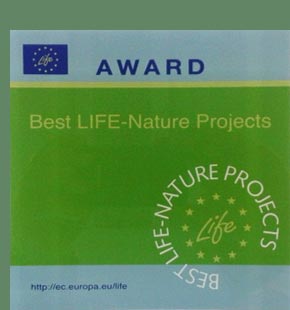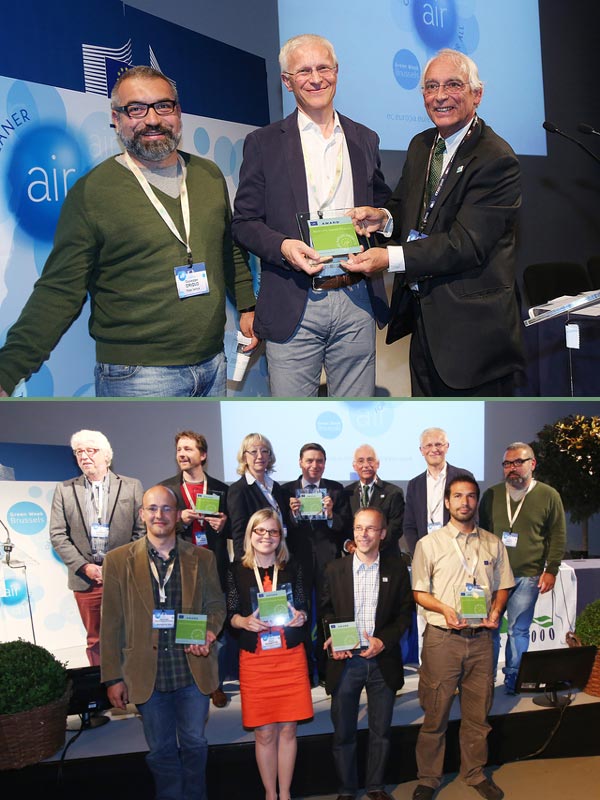
Welcome to the project site LIFE06NAT/IT/000060 “Conservation and restoration of calcareous fens in Friuli”. The purpose of this project is the environmental conservation of the last alkaline fens of the Friuli lowland, their restoration and the protection of the related endangered endemic rare plants, which still survive there.
From 31.12.2013 this website will no longer be updated but it will continue statically to perform an informative function about the completed project . 


Bruxelles June, 5 2013 The European Commission consignes an international award to our project - LIFE FRIULI FENS, judged one of the best LIFE NATURA projects concluded on 2012 in the EU. Our project has awarded with the plaque "best LIFE Natura project" delivered Il nostro progetto è stato premiato con la targa “miglior progetto LIFE Natura” consigned during the official ceremony held in the EU conference centre in Bruxelles as part of the "Green Week" 2013. The project and its achievements have been briefly described by our representative with the other seven ended in 2012 and evaluated as "best". In the assessment of the Final Report, the European Commission welcomed the great achievements in the restoration of alkaline calcareous fens and wet meadows for the propagation of more than 80 herbaceous species, including species of Community interest Armeria Helodes and Erucastrum Palustre, as well as for extraordinary maintenance of natural habitats, the Commission emphasizes the importance of precise management guidelines assumptions, described by '"After Life conservation plan" and also in the management plans for the areas. | 
|





April 2013 The European Union communicated to us that "Life Friuli Fens" project is one of the best eight LIFE Natura projects among twentyone concluded during 2012, we will receive an award plaque and our project will be present in a specifical brochure inside the LIFE website.
Member States are also evaluating mentioned projects to award the two "Best of the Best projects". The results should be announced in May.  SHOW PDF SHOW PDF



November 2012 The project has been completed and today the whole resourgences ecological system is in better condition than six years ago. To learn more, read the layman's report of the project in the "downloads" section. 


September 2011 On September 23, 2011 at the Udine headquarters of Friuli Venezia Giulia Region was held the final conference of the project LIFE06NAT/IT/000060 "Conservation and restoration of calcareous fens in Friuli". Click here to open the conference page. 





May 2011 Microhabitats creation works in progress in the Flambro and Virco fens
and in the Corno swamp. Microhabitats are limited areas of fen - from one to four square meters - adequately prepared for the transplant of Erucastrum palustre and Armeria helodes little plants. These areas have been identified after careful examination of the existing ecological factors (physical and biological), of the needs of both species and of the distribution of known populations. Was also evaluated the relative position of recent and existing environmental restoration as both can host new populations of Erucastrum and Armeria. The fen vegetation is typically dense and each space potentially available is occupied. The soil, low in nutrients, induces a boost competition among individuals who develop aerial and radicals equipments able to maintain the space gained. The germination of new seedlings is therefore closely related to the possibility of developing a root system and sufficient to withstand the growing competition from existing plants.
The mode of action, as seen in the pictures 1 and 2, consist in the clearcutting of the heads on a grassy area of 1.4 square meters. with a brush cutter blade. The purpose of this action is to create a space between the existing vegetation, a"window" that enables individuals transplanted to grow in conditions of low competition.
The specimens used in transplants come from protected environment crops, managed by the Service from the nursery property. (pictures 3, 4, 5, 6). Subsequently, the heads of larger diameter are drilled specifically for the purpose of introducing and planting Armeria helodes. (pictures 7, 8, 9, 10). This should temporarily depress the competitiveness and thus promote the engraftment of the transplanted specimens. Then repeat the cuts may be necessary in order to continue to promote the growth of transplanted seedlings. (pictures 11, 12)



May 2010 New transplants performed in the restored areas. 

March 2010 The rehabilitation works of habitat near the Rio Raffeletto, in the regional natural biotope of Torbiera Selvote (Castions common), are running. 
|